 Relevancy and Engagement
agclassroom.org/il/
Relevancy and Engagement
agclassroom.org/il/
Lesson Plan
Say Cheese for Protein
Grade Level
Purpose
Explore protein, discover the role of amino acids, identify dietary sources of complete and incomplete proteins, and make fresh mozzarella cheese—a food science experience where students will observe the protein in milk (whey and casein) separate from water in the creation of cheese. Grades 9-12
Estimated Time
Materials Needed
Engage:
- Types of Cheese image
Activity 1: Amino Acids and Proteins
- Building Proteins Scrabble, 1 copy (front to back) per group of 3-4 students
- Protein PowerPoint slides
- Say Cheese for Protein student handout, 1 copy per student (Teacher Key)
Activity 2: The Science of Cheesemaking
- Say Cheese for Protein student handout, (continued from Activity 1)
- Physical Composition of Milk graphic
- Mozzarella Cheese recipe, 1 copy for teacher or 1 copy per student group
- Ingredients:
- 1 gallon of whole milk (2% also works)
- ½ cup water (split)
- 1 ½ tsp citric acid*
- Rennet*
- Be sure to purchase rennet from a cheesemaking supplier or agclassroomstore.com. The rennet commonly available at a grocery store is primarily for desserts and is not adequate to form a true curd for mozzarella cheese.
- 1-3 tsp salt
- Kitchen supplies:
- Large pot with lid
- Colander
- Microwave safe bowl
- Long knife to cut curds
- Slotted spoon
- 2 small bowls
- Thermometer
- Measuring cups and spoons
- Stove or hot plate
- Microwave
- A Brief History of Cheese video
- Crackers
- Toothpicks, napkins, and paper plates for taste-testing
*These supplies can be purchased in the Mozzarella Cheese kit from agclassroomstore.com.
Activity 3: Complete and Incomplete Sources of Proteins
- Say Cheese for Protein student handout, (continued from Activities 1 and 2)
- Protein PowerPoint slides
- Protein Food Cards
- Purchase cards from agclassroomstore.com
- Print your own, 1 copy (printed front to back) per group
Vocabulary
amino acid: biochemical units from which all proteins are made; twenty different amino acids occur most commonly in the proteins of all life forms
casein: a protein that makes up about 80% of milk
cheese: a food made from pressed curds of milk
coagulate: to change to a solid or semi-solid state
curd: clumps of casein (coagulated protein) that separates from the liquid when milk coagulates
enzyme: protein catalyst, which speeds up a specific chemical reaction
milk: an opaque white fluid rich in fat and protein, secreted by female mammals for the nourishment of their young
protein: an essential nutrient responsible for building tissue, cells, and muscle
rennet: a complex set of enzymes produced in the stomach of young ruminant animals
whey: liquid that drains from the curd of clotted milk; contains lactose, proteins, water-soluble vitamins, and some minerals
Did You Know?
- Proteins are found throughout the body with over 40% found in skeletal muscle, 25% found in body organs, and the rest mostly in the skin and blood.1
- It is believed that cheese was discovered by accident in early civilizations when milk was stored in a pouch made from the stomach of animals. Rennet, an enzyme found in the stomach of ruminant animals, would cause the milk to coagulate and separate into curds and whey.8
- Cheese is a great source of calcium, fat, and protein. It also contains high amounts of vitamins A and B12 and riboflavin.9
Background Agricultural Connections
Protein and Amino Acids
Proteins are an essential part of the diet because they contain the constituent amino acids which allow the body to synthesize its own variety of proteins and nitrogen-containing molecules. The structure and characteristics of a protein are largely based on the amino acids which build protein and result in varying ways it will react when agitated, heated, or any other number of physical changes to its environment.1
Proteins have several functional roles which make them very useful in the food preparation process. This includes forming a foam, acting as a thickening agent, or a structural component of the food.2 In the body, proteins function in a variety of ways including acting as a catalyst, messengers, structural elements, buffers, fluid balancers, immunoprotectors, transporters, and many other roles. On a higher level, proteins work to build and repair the tissues in the body.1
Dietary Protein
There are two basic forms of protein in cheese—whey and casein. The distinction between the two proteins becomes evident in the cheesemaking process. Once the pH of milk is adjusted to 4.6 (after the addition of an acid) and rennet is added, the casein becomes insoluble and coagulates together into a curd while the whey remains in the liquid and is drained from the curd in the cheesemaking process.
The characteristics of the side chains of the protein will determine the structure and functional role in the body as well as determine if it can be synthesized by the body or must be ingested.1 The building blocks of proteins are amino acids. There are 20 amino acids the body will utilize regularly and two additional amino acids that are not used as frequently.10 If a protein can be synthesized by the body it is considered nutritionally non-essential, and if it cannot be synthesized by the body it is nutritionally essential. There are 9 essential amino acids. Additionally, in certain conditions or chronic diseases, there are 5 other amino acids which can become essential.1
Complete vs Incomplete Proteins
There are many different sources of protein in the diet, and one way to categorize them is by considering which protein foods contain all the essential amino acids. A complete source of protein contains all 9 essential amino acids while an incomplete protein source (legumes, nuts, seeds, and whole grains) may contain some, but not all essential amino acids. Complete sources of protein are commonly thought of as animal products (fish, poultry, eggs, beef, pork, dairy), though it can include some plant-based proteins as well (soy, tofu, tempeh, edamame). If a person chooses not to eat animal products they can still get the protein their body needs it is just important to eat a variety of plant-based sources and complementary sources of protein that will give them all the different essential amino acids.11
Origin of cheese
Cheese is one of many products made from milk. The exact date of origin for cheese is unknown, but it has been found in Egyptian tombs and murals from 4,000 years ago. It is thought that cheese was discovered by accident when it was common to store milk in a container made from an animal stomach. The enzyme, rennet, is found in ruminant stomachs. When added to milk it causes milk to coagulate and separate curds (solid proteins) from whey (liquid). This means when someone would store milk in a ruminant stomach (a common practice before glass and plastic), their milk would turn to fresh cheese.
Today, the art of making cheese has become much more technical.3 Now there are hundreds of cheese varieties which can be grouped into eight categories including blue, hard, pasta filata, processed, semi-hard, semi-soft, soft and fresh, and soft-ripened.4 Currently more than one-third of all milk produced each year in the United States is made into cheese.5
Cheesemaking Process
The cheesemaking process uses science and chemistry to remove whey and liquid from milk to form a curd (cheese).6 Along with a vast array of cheese types, there is also a variety of cheese-making processes. Each process shares the same basic components:
- Milk: All cheese is made from milk. In the United States, milk from cows is most common. However, many specialty cheeses are made from the milk of sheep, goats, and other mammals. Milk is composed of varying amounts of carbohydrates (lactose), fat, protein (casein and whey), vitamins, and minerals.
- Acid: Soft cheeses are made by adding a type of acid to milk to make it coagulate. Citric acid and vinegar are two examples of acids used in the cheesemaking process.
- Bacterial Cultures: Chemical changes in milk can be triggered using bacterial cultures. The use of beneficial bacteria creates chemical responses in the cheese to enhance specific flavors.
- Enzymes: The most common enzyme used to make cheese is Rennet. Rennet causes the milk to coagulate and is used to make hard cheeses.7 It helps the milk mixture separate the forming curds from the whey. Rennet splits off the hydrophilic portion of the casein micelles so it will no longer stay suspended in the aqueous solution of milk. Instead, the casein aggregates together to form the curds, while the whey (or liquid portion) separates.6
- Time: Some cheeses can be made in a short amount of time and others require aging to develop the proper flavor, texture, and moisture levels.
- Heat: Precise temperatures allow the enzymes and bacterial cultures to work properly in the cheesemaking process by allowing the beneficial bacteria to do its work.7
- Salt: Salting helps draw out additional moisture in the cheesemaking process. It also plays a huge role in the flavor of cheese.
Engage
- Conduct a survey in class to determine what varieties of cheese are your student's favorites.
- Project the Types of Cheese image on the white board. Instruct students to put a tally mark by three of their favorite cheeses. Tally the results and use the following questions to discuss cheese:
- What are your favorite ways to eat cheese—plain or as an ingredient of a recipe?
- What foods are much better with cheese?
- Are there any cheeses that you've never tried?
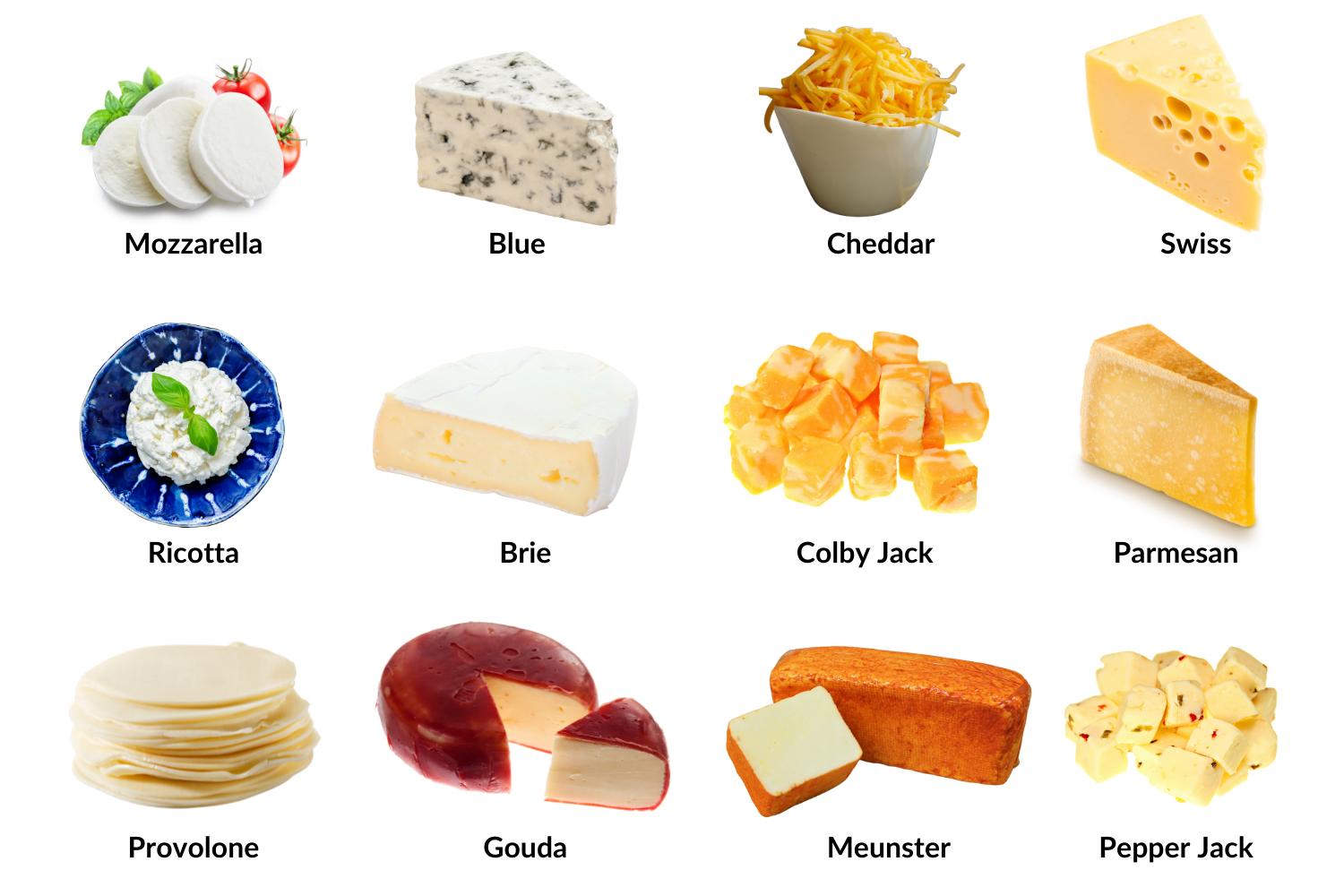
Explore and Explain
Activity 1: Amino Acids and Proteins
- Prior to class, follow the instructions on the Building Proteins Scrabble to prepare one set of Scrabble letters for every group of 3-4 students.
- Ask students if they have ever played the game Scrabble. Tell students that you are going to play a version of this game. Divide the class into groups of 3-4 students. Give each group one set of the Building Proteins Scrabble letter tiles.
- Instruct students to spread out their tiles with the letters facing up.
- Set a timer for 3-5 minutes. Instruct students to create as many words as they can from their letter tiles. Words can be formed across and down, but not diagonally.
- When the time is up, determine how many words each group came up with. Have the group with the most words share.
- Explain to the students that in this game there were 20 letters that could be arranged into multiple different words. The same 26 letters make up countless words in our vocabulary by being arranged and rearranged.
- Ask students to turn over their letter tiles. Ask students if they are familiar with any of the words on the back. Have they seen these words anywhere?
- Explain that each tile represents an amino acid. Just like letters are the building blocks of words, amino acids are the building blocks of proteins.
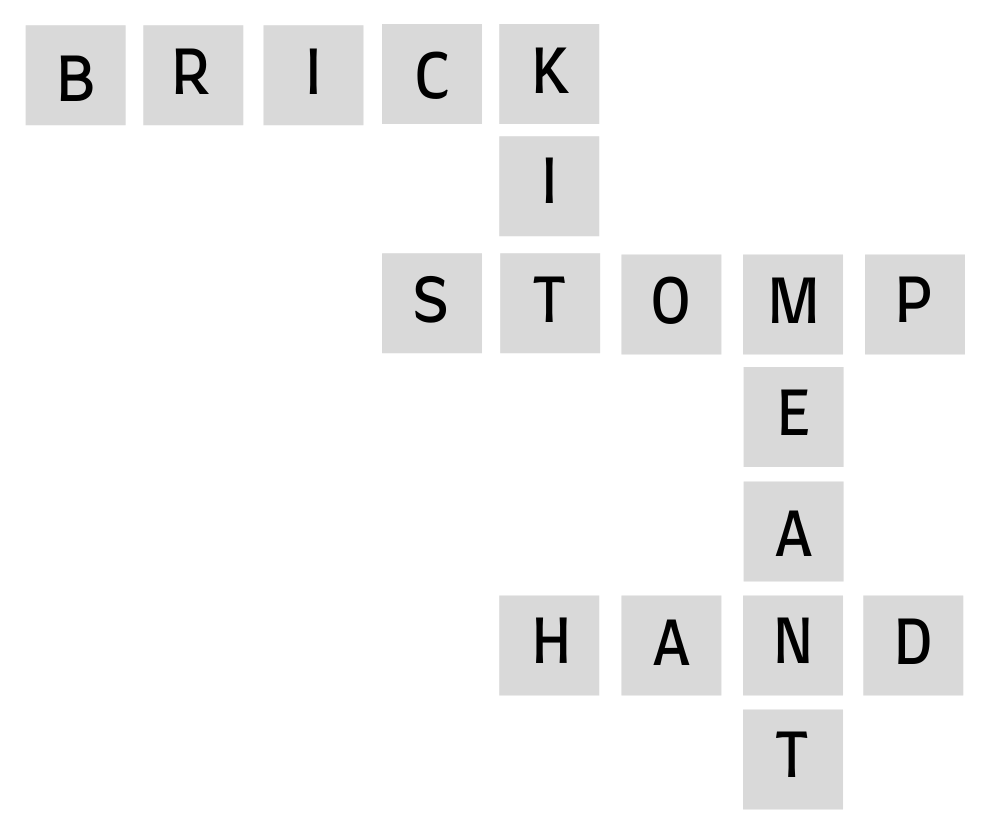
- Open the Protein PowerPoint slides and give each student one copy of the Say Cheese for Protein student handout. The slide deck and handout will guide your discussion as you proceed through the activity.
- Ask students, “What do you know about proteins and amino acids? Discuss their answers to evaluate their prior knowledge. Use slides 3-4 to explain.
- Refer students back to their amino acid tiles. There are 20 common amino acids (slide 5). Point out that there are two different colors of amino acids on the back of their letter tiles. Have students group them according to color.
- Explain that the amino acids with a solid green circle are essential, which means our body has to acquire these amino acids from the food we eat. Whereas the amino acids with a blue dotted circle are non-essential. Our body can make these amino acids if we consume enough protein in our diet (slides 6-7).
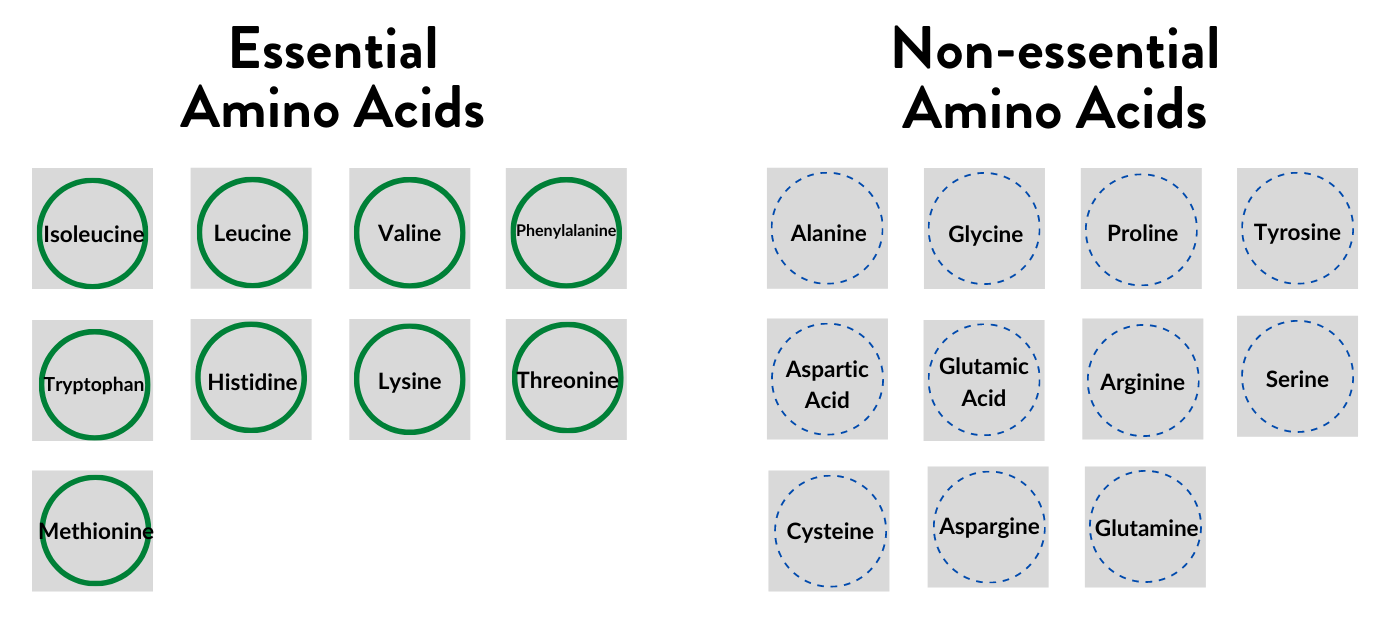
- Have students count and report how many essential amino acids there are (9) and how many total (20) amino acids (slide 8).
When studying amino acids, you may find resources stating that there are 21 or 22 amino acids rather than the 20 used in this lesson. This variation can be explained because there are 20 amino acids the body will utilize regularly and two additional amino acids that are not used as frequently.10 - Ask, "What type of foods do we eat to obtain the amino acids our body needs to be healthy?" (slide 9)
- Ask students, “What foods are good sources of dietary protein?” (slide 10) Brainstorm a list on the board.
- Explain that protein is a food group in MyPlate. It includes meat, poultry, eggs, nuts, beans, and seeds (slide 11).
- Ask students, “What are proteins used for in the body?” Explain that the primary purpose of proteins is to build and repair our body tissues. In addition, proteins also function as a catalyst, messengers, structural elements, buffers, fluid balancers, immunoprotectors, transporters, and many other roles (slide 12).
- In order for your body to be able to perform all of these roles, you need to eat protein sources everyday, and several times per day.
- Explain that MyPlate gives a daily recommendation for how much protein we should consume at different phases of life (slide 13). The recommendations are measured in ounce-equivalents. Give a few examples of ounce equivalents (slide 14).
Activity 2: The Science of Cheesemaking
Preparation: Prior to class, gather the ingredients and kitchen supplies outlined in the Mozzarella Cheese recipe. If possible, make the recipe once before class if you have never made it before. The Making Mozzarella Cheese in the Classroom video can also help illustrate the steps. Determine if you will make the cheese as a demonstration or if your students can make their own batches of cheese based on the resources you have available.
- Teacher Demonstration: Set up a hot plate (or stove if available) in front of the class or in an area where students can best watch each step of the cheesemaking process. The step-by-step instructions below are for a demonstration of making mozzarella cheese. Consider the following tips gathered from the pilot testing of the lesson:
- The teacher demonstration is recommended for class periods shorter than 1 hour or for students with little to no cooking experience.
- Student Lab Participation: If you have kitchen lab space and supplies available, allow student groups to each make their own batch of cheese. See the following tips gathered from the pilot testing of the lesson:
- Do a demonstration of the cheesemaking process for your students before they attempt to make their own cheese.
- Encourage students to taste the cheese from your demonstration before attempting to make their own. They are more likely to be engaged in the process if they realize the homemade cheese will taste like the cheese they are accustomed to.
- Help students avoid mixing up the citric acid and the rennet in the recipe by distributing the milk and citric acid first, and the rennet after the citric acid has been added.
- Be sure students do not overheat the milk. If they do, the recipe will fail because the added heat will change the milk proteins and the enzyme will not have the same effect.
- The cheese recipe can be made in 30 minutes. However, it took 60-70 minutes for high school students to complete the process in the pilot testing.
Lab Procedures:
- Show the Healthy Snack Box Ideas image to the class (slide 16). Ask students to identify what each box has in common. (no added sugars, fresh fruits and vegetables, only whole grain carbohydrates, protein, etc.)
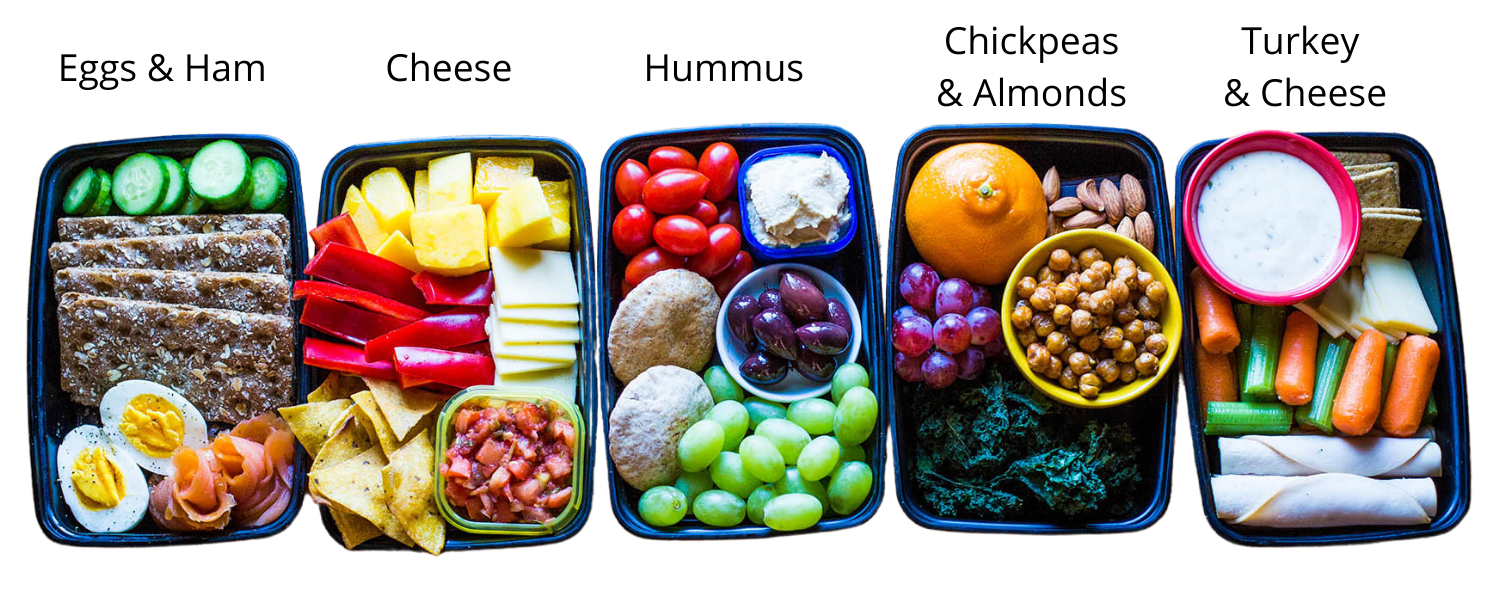
- Have students turn to Part 2 of the Say Cheese for Protein student handout.
- Ask students, "Why do you think protein foods are included in each snack box?" Explain that when our body digests protein it supplies a more steady and longer lasting supply of energy to our body than if we consume common snack foods made primarily of refined carbohydrates and added sugars.
- Help students identify the snack box foods from the protein food group.
- Introduce the cooking lab by explaining that they are going to be using science to make one of these proteins—cheese.
- Display the Physical Composition of Milk graphic (slide 17). Explain that milk is composed of five things—water, lactose, fat, protein, and minerals. Hold up your gallon of milk and ask students how they can remove the water from the milk. Allow students to offer their ideas.
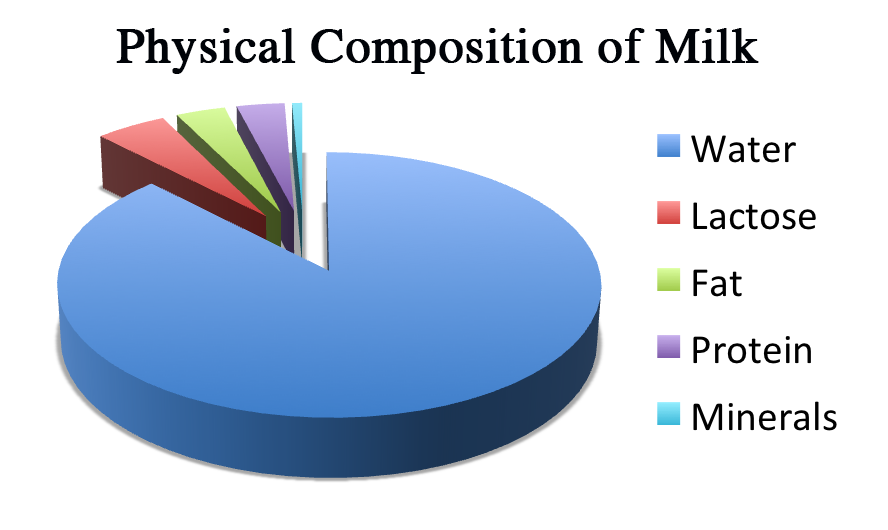
- Explain that you'll need to use science. Cheese is made by removing a large percentage of water from milk using science and chemistry.
- Begin the cheesemaking process by following the step-by-step instructions from the Mozzarella Cheese Recipe. Project the recipe on the board to help students follow along. As you demonstrate the cheesemaking process, students should be answering the questions on page 3 of their Say Cheese for Protein! worksheet.
- During step 6 of the cheesemaking process there will be a 10 minute wait while the milk coagulates. Watch A Brief History of Cheese.
- After the video clip, discuss the following questions:
- How did milk and the discovery of cheese give Neolithic people a survival advantage? (Milk was rich with nutrients and cheese provided an opportunity to store food that would otherwise spoil.)
- Where is rennet produced? (Rennet is made in the stomach of some animals.)
- The video clip and discussion should complete in time to return to step 7 of the cheesemaking process.
- When the cheese is complete, provide an opportunity for students to taste. Students should find the flavor and texture of the homemade cheese very familiar as long as the salt was adequately distributed in the kneading process. Refer to the ideas below for eating homemade cheese. Fresh mozzarella can be refrigerated and then grated. However, eating it fresh is recommended because it melts and browns faster in the oven than store-bought mozzarella.

- Refer to the Teacher Key to help students complete page three of their Say Cheese for Protein! student handout.
- If time and resources are available, allow students to make their own batch of cheese in small groups using the tips outlined in the Preparation section above.
Activity 3: Complete and Incomplete Sources of Proteins
- Divide students into groups of 3-4 students. Give each group one set of Protein Food Cards.
- Instruct students to shuffle through the cards and read the information on the front and back. Set a timer for 3-5 minutes for students to accomplish the task.
- After the time is up, lead a class discussion about what students learned from the cards. Use the following questions to guide the discussion:
- What nutrient does each of the food have in common? (protein)
- Which food(s) contained the most protein per serving?
- Which food(s) contained the least protein per serving?
- What MyPlate food group(s) have foods that contain protein?
- Were there any foods you were surprised to see that they contained protein?
As students analyze the Protein Food Cards throughout this activity, be sure they make the connection that protein is a nutrient found in multiple foods and MyPlate food groups. Foods from the Protein and Dairy food group contain higher concentrations of protein, but protein can be found in some vegetables and grains as well.
- Review the basic concepts about amino acids from Activity 1. Students should be able to recall and explain what essential and non-essential amino acids are.
- Instruct students to sort their Protein Food Cards into two piles according to the information given about the amino acids they contain.
- Open the Protein PowerPoint slides and have students refer to Part 3 of their Say Cheese for Protein student handouts. Introduce the concept of complete and incomplete proteins. Explain that a complete protein is one that contains an adequate amount of all the essential amino acids. An incomplete protein does not contain all 9 essential amino acids (slides 19-20).
- Have students take another look at the piles they created in step five and confirm that one pile contains foods that are complete proteins and the other pile includes foods that are incomplete proteins.
- Once students have separated their foods correctly, ask them if they see any patterns or similarities among the foods in each stack.
- Students should recognize that animal-source foods are always complete proteins. Examples include meat, milk, and eggs. There are only a few plant-based foods that contain all the essential amino acids (complete proteins).
- Explain that if an individual eats both plant- and animal-source foods, it is relatively easy to consume the dietary protein needed for overall health. It is a healthy practice to eat protein from a variety of sources.
- Ask, "How can an individual with a vegetarian diet meet the protein requirement?" (slide 21)
- Define a vegetarian diet as one that does not include meat. Have students remove all of the cards with meat and determine what foods are left. Students should recognize that there is still a variety of protein foods to select from. Have students identify how many complete and incomplete proteins are left.
- Next ask, "How can an individual with a vegan diet meet their protein requirement?" (slide 22)
- Describe a vegan diet as one that does not include any animal-source foods. Have students remove all animal-source foods from their pile to see what foods remain. Are there any complete proteins?
- Introduce the concept of complementary proteins. Draw attention to the food cards representing incomplete proteins. Note that these foods include specific amino acids that are particularly low or not existant as well as others that are high (slide 23-24).
- Challenge students to pair the incomplete proteins in a way that if consumed together, their body would receive all the required amino acids. Note that the examples illustrated with the food cards are just a small illustration of the concept. Protein requirements can be met with a conscientious plant-based diet if desired.
- Conclude by discussing the value of protein in the diet and the consequences of undernourishment that could include stunted growth, lower resistance to disease, unhealthy weight loss, and exhaustion. Protein deficiencies occur, but are uncommon in the U.S. However, other countries throughout the world have higher incidences (slide 25).
Elaborate
-
Watch, What Cheese Looks Like Around the World to explore the legends and myths behind the invention of cheese and see what cheese looks like in different parts of the world.
-
Beans, peas, and lentils are unique foods that can be counted as part of the vegetable food group or the protein food group depending on your diet. Discover more about these foods, commonly known as pulses.
-
Explore the functions of protein from a culinary aspect:
- Structure and texture (Egg whites give the airy texture of angel food cake.)
- Thickening agent (Milk proteins increase yogurt's thickness.)
- Change the structural component of food. (In the cheesemaking process a chemical change causes the protein in milk to go from a liquid to a solid.)
-
Discuss how consumers create demand for specific foods. Ask the question, "If milk is white, why is some cheese (cheddar for example) yellow?" To answer the question, play the video How Milk Becomes Cheese. The question is answered from 4:06-6:40.
-
After making the cheese, discuss the use and value of the remaining whey. Remind students that whey is a milk protein that remains in the water during the cheesemaking process. Ask students where they see or hear about whey protein (protein supplement drinks). Whey protein is a by-product of cheesemaking. Watch How BPI's Whey Protein is Made. (Note that this video advertises a specific brand of protein powder. Direct student attention to the process and source of whey protein powder. Begin the video at 0:29)
Evaluate
After conducting these activities, review and summarize the following key concepts:
- Amino acids are the building blocks of protein. Essential amino acids must be acquired in our diet. Non-essential amino acids can be synthesized by our body.
- Cheese is made when an enzyme is added to milk that separates the proteins (primarily whey and casein) from the water.
- Foods are considered complete proteins when they contain all nine essential amino acids.
- Incomplete proteins contain fewer than the nine essential amino acids.
Sources
- Advanced Nutrition and Human Metabolism. Gropper and Smith. 2013
- Foods Experimental Perspectives. Margaret McWilliams. 2012
- https://nationalhistoriccheesemakingcenter.org/history-of-cheese/
- https://www.usdairy.com/news-articles/cheese-types-what-you-need-to-know-about-cheese
- https://www.idfa.org/history-of-cheese
- Foods Experimental Perspectives. 7th edition. Margaret McWilliams
- Say Cheese! A Kid's Guide to Cheese Making. Ricki Carroll and Sarah Carroll
- https://nationalhistoriccheesemakingcenter.org/history-of-cheese/
- https://www.hsph.harvard.edu/nutritionsource/cheese/
- https://www.hsph.harvard.edu/nutritionsource/what-should-you-eat/protein/
- https://health.clevelandclinic.org/do-i-need-to-worry-about-eating-complete-proteins/